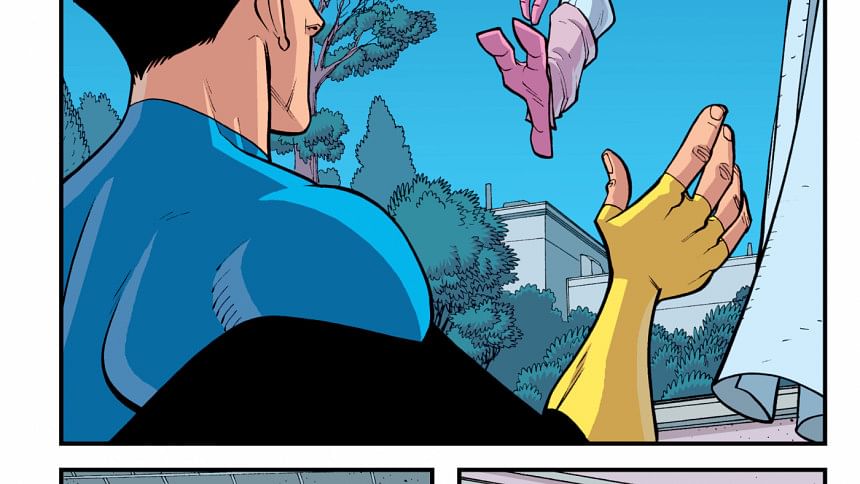A truly ‘Invincible’ comic book series

While DC and Marvel, the two big dogs of the comic book industry, have been reigning the superhero comic book genre for decades, the left-of-mainstream publisher Image Comics released issue 1 of Invincible in January 2003. Little did anyone realise back then that this new superhero series, among many already existing ones, would stand out, become a fan favorite, and run for 15 years straight!
On many issues of this series you will see the words "The best superhero comic book in the universe!" on the cover, and a lot of fans will agree with it whether it's factually accurate or not. Now that the animated TV show adaptation of the same name is out, streaming on Amazon Prime Video, Invincible is getting a fresh new spotlight for non-comic book readers. But let me tell you why the comic book experience, written by Robert Kirkman and illustrated by Cory Walker and Ryan Ottley, is better.
But before all that, 'Parental Advisory' alert! Invincible can often get very violent. And I mean graphically violent! The art does not shy away from emphasising the severity of the situation in a very disturbing way, especially during fights among super beings—heads get blown up by bare hands, in the Game of Thrones-style, hands go through torsos like a spear, and often limbs get torn apart. However, these violent scenes are not portrayed realistically, but rather in a cartoonish four colour artstyle which somehow mitigates the extent of the gore. Think Batman: The Animated Series, with lots of blood and gore—it's graphic, but still limited within its style of animation.
The plot
The set up and basic premise is nothing unprecedented. We've got a world filled with superheroes and supervillains. Villains attack and heroes defend. The government gets involved. There are threats, starting from a crime in a dark alley to the kinds that can destroy the world. Nothing new so far. But the way the writer zooms in and focuses on micro level issues related to all these characters is something that makes this graphic novel unique, super fun, and often scary to read.
When a superhero punches a supervillain, we all cheer. But what about the collateral damage during that fight which causes a building to drop on a crowds of people, leading to casualties? Even though a lot of similar narratives cleverly ignore these ugly consequences, Invincible often seems to zoom in on that and remind us that the daily life of a superpowered being can often lead to irreversible and grim ramifications that cannot always be avoided. But here's a heads up: the first six issues might seem a bit of a casual read. But don't be fooled, because things start going sideways from issue seven.
This is where writer Robert Kirkman shines the most—he twists and turns and bends this age-old genre in such a way that it leaves one's jaw dropped. There are shocking betrayals, weird alien races, unexpected and unlikely team-ups, and brutal murders and deaths that will leave you thinking, "I did not see this one coming!" The writer manages to mix together a winning formula of coming-of-age, science fiction, action, and superhero-soap opera. Kirkman is also the creator of The Walking Dead (Image Comics) graphic novel, whose TV adaptation used to be one of the top shows going shoulder-to-shoulder with Game of Thrones. Add to that the clean, four colour art of co-creator Cory Walker, and later, Ryan Ottley, and you have a visual treat of 144 issues! More on the writing and artwork later.
The hero, the villains, and others
Mark Grayson, aka the superhero Invincible, is a typical high-school student from a middle class family. But growing up, he had to keep a big secret—he is the son of the most powerful superhero on Earth, Omni-man, whose alter ego is a novelist by the name of Nolan Grayson. Mark's mother Deborah Grayson, one of my favorite side-characters, is a "normal" human being and homemaker.
One fine evening, Mark gets super strength, super speed, and flying abilities just like his father. But what makes him a hero and not a villain with super powers? He did not have to suffer through any shocking murder of a family member like Bruce Wayne or Peter Parker. Instead, he was raised by idealistic parents, and he grew up looking up to his father accomplishing heroic deeds all over the world. As a result, Mark's primary motivation is to always do what's right.
But life is cruel, even for the second most powerful superhero on Earth. Apart from some shocking events about which I won't tell you (remember this line after you finish issue 12), Mark has to maintain his secret identity, be on call for the government 24/7 to save the world, and accomplish daring outer space missions, all the while trying to somehow piece together a personal life along with maintaining studies (so many missed classes!).
He also has to deal with a ridiculously extensive and varied rogues' gallery! From superheroes turned supervillains and an army of underground creatures to clone-making genius twins and a cross-dimensional evil scientist, we've got it all, and that's just on Earth! I am not even going to tell you about the threats from outer-space! Mark my words (pun not intended), there is no lack of baddies in the Invincible universe, and often it can get too much in too little time!
Apart from a rich roster of villains, Invincible has a number of great side characters who elevate the narrative of this superhero soap opera. Mark leads a double life. So, naturally, he has friends and acquaintances in both circles that affect him in many ways. Apart from the ever-shifting dynamics of these relationships, we are often illuminated about the backstory and origin of a lot of these characters, which adds depth and personality. You will discover as you read on why these characters behave the way they do, what tragedies and traumas they went through, and how their perspectives of the same world crisis are sometimes quite varied.
The writer and the artists

Besides The Walking Dead, Invincible, in my opinion, is one of Robert Kirkman's great creations. The problem with DC and Marvel superhero comics is that they keep on changing writers. But when you have one writer with his own vision and freedom to consistently write 144 issues of superhero lore, the overall flow of the narrative and the development of characters never feels out of place. With so many characters, it's very important to pull readers in and make them care about each of the characters. It's important to make characters feel alive and unique, through the ways in which they behave, interact, and develop over time. Kirkman succeeds brilliantly at this. There are clever dialogues and puns, heart breaking conversations, cheesy one liners well placed, complex scientific concepts easily explained, and more.
Fun fact: Robert Kirkman is one of the five partners of Image Comics, the only one who is not a co-founder. He also got some work done in Marvel in Ultimate X-Men, Irredeemable Ant-Man and Marvel Zombies. Some of his other works in Image Comics include Tech Jacket, Outcast, and Oblivion Song.
And the art. Ah the art! Co-creator Cory Walker draws from issues one to seven with intermittent contributions later on, and then Ryan Ottley takes charge from issue eight till the end. All issues are brilliantly coloured by Bill Crabtree.
A compelling narrative with all its twists and turns is ineffective if the reader does not care about the characters. In this case, it's the art that adds to the great dialogues and puts life in the characters, in their body language and facial expressions, when they are speaking and when they are silent.
Furthermore, this graphic novel is filled with grand-level action! As you follow the fights from panel to panel, you really enjoy how fluidly they flow and how cinematic the framing or the "camera-view" of each panel is. And oh the details of the destruction surrounding the epic fights! *chef's kiss*
You might be thinking, "I've watched the animated TV show. No need for me to read the comics. I'll just wait for the new season". I get it, you are probably not a reader. But here's the thing—the source material is almost always better than any form of adaptation. I read the comics first and then watched the TV show myself, and enjoyed both. But the TV show has abridged and removed a lot from the books. For example, in the comics there are more interactions, more dialogues, more side stories, and more in-depth explorations into the characters, to name a few; this in comparison with the adaptation's excellent soundtrack and intense, final episodes. But if you want to dive deep into the universe of Invincible, the comic book is the best medium.
Kaisar Kabir is a radio show host and pop-culture enthusiast.

 For all latest news, follow The Daily Star's Google News channel.
For all latest news, follow The Daily Star's Google News channel. 



Comments